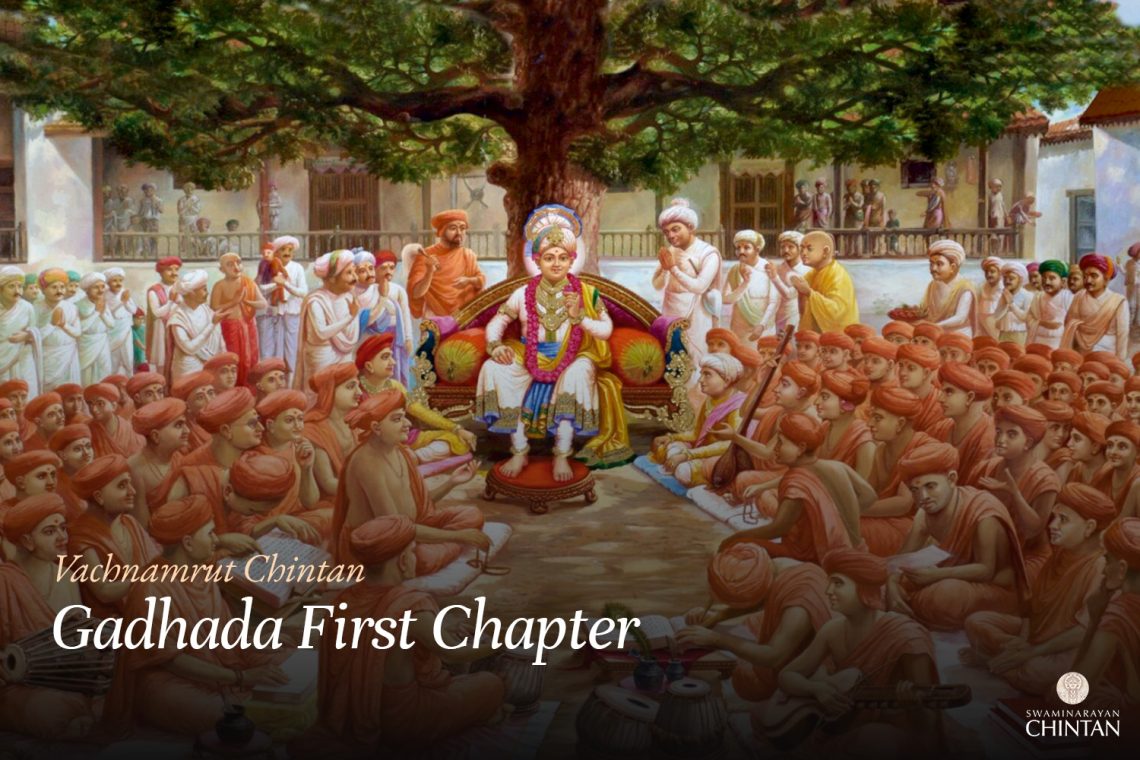Central Insights:
- What is the distinction between Sharir and Shariri?
Key Points:
- The soul is Sharir because it is a by-product of creation, dependent and powerless.
- God is Shariri because of His power of pervasive, independent, and all capable.
Explanation
In this Vachanamrut, Shriji Maharaj specifically discusses the relationship between God, the jīva (soul), and the world, describing it as a sharir-shariri relationship. God is the shariri (soul), and the jīva and the world are His sharir (body). Maharaj raises an internal question: there must be significant distinctions between the sharir and the shariri. The sharir is subject to change, while the shariri is unchanging. The sharir is perishable, while the shariri is imperishable. The Upanishads state, “yasya ātmā shariram, yasya akṣaram shariram” (He whose soul is His body, He whose akṣara is His body). However, the soul and akṣara are of the same essence as God. Maharaj questions why the soul and akṣara, which are the sharir of God, are not like the material body which is perishable and subject to change. He then provides the resolution to this question.
First, Maharaj explains that it is necessary to understand the definition of a sharir. The common definition is that which perishes. This definition is partial and incomplete. For a definition to be complete, it must be universally applicable. Thus, the common definition is insufficient. The true characteristics of a sharir, as described by Maharaj in the Vachanamrut, are that it is pervaded, dependent, and powerless. It is not necessary for it to be material, perishable, and subject to change. The sharir must be the abode in which the shariri pervades. It must be subordinate to the shariri, meaning it must be under the control or governance of the shariri. Compared to the shariri, it must be powerless. Therefore, since the soul and akṣara exhibit these three characteristics, they are considered the sharir of God. Thus, the scriptures and great acharyas state that the soul and akṣara are indeed the sharir of God, even though they are not perishable or subject to change.
Furthermore, Maharaj addresses another common misconception. It is often believed that in the sharir-shariri relationship between the jīva and God, the sharir must inherently possess qualities such as being material, perishable, and subject to change. However, this is not a requirement. The true definition of a sharir is that it is pervaded, dependent, and powerless. Similarly, it is believed that since the shariri is pervasive, it must be formless. Maharaj refutes this misconception, explaining that just as the formless soul resides within a physical sharir, a pervasive entity does not necessarily have to be formless. The pervasive shariri resides in a physical form, and thus, the pervasive shariri can also have a form. Therefore, believing that the shariri must be formless is a misunderstanding.
Paramatma (God) is the shariri (soul) of everyone and pervades everywhere, yet He is not formless; He always has a form and possesses a divine shape. God pervades through tangible objects and also through intangible entities while maintaining His form. As Antaryami (inner controller), as the form of light, and as a tangible entity, God pervades everything. No gross or subtle coverings can obstruct God. Pervasiveness means that wherever a pervasive entity exists, no part of the pervaded object is without the existence of the pervasive entity. Thus, despite being tangible, God possesses the incredible capacity to pervade even the smallest particles.
Then, a question arises: if God has a form, why do we not experience or perceive Him? The resolution to this is not that God is formless, hence we do not perceive Him. The reason is different. We lack the appropriate method and full capacity to perceive or experience His tangible presence. Maharaj has indicated in the Vachanamrut that if one worships and performs bhakti (devotion) considering God as having a form, then one can perceive or experience Him.
Through love and service (bhakti and upasana) between Paramatma and His devoted followers, one can have His vision and experience. Shriji Maharaj has stated that whenever a soul has made an effort, it has seen God. If one contemplates the glory of God and makes an effort, one will surely experience Him. Moreover, through God, one attains infinite aishvarya (glory) and immense happiness. If one performs upasana considering God to be formless, one may merge into Brahmasushupti (a state of deep meditation on the Brahman) but does not attain any aishvarya. Maharaj says that these accounts are narrated based on direct experience and such experiences are attained by those who have unwavering faith in God’s always-divine and tangible form, but not by others.
Additionally, in this Vachanamrut, the relationship between the jiva (soul), the world, and Paramatma is discussed. Shankaracharya believed in a unified relationship, meaning that ‘the soul is the same as Paramatma’, which is known in logic as a relationship of identity. For example, oil and its stickiness or water and its wave, they share a relationship of identity. Such is the relationship between the jiva and God.
Ramanujacharya posited a shesha-sheshi relationship. God is the sheshi (master), the owner, while the jiva and the world are shesha (dependents), His property, His possessions. Shriji Maharaj expanded on this by advocating a swami-sevakbhav relationship, where Shriji Maharaj is the master (swami) of all jivas and the world. All jivas, whether liberated (mukta), seekers of liberation (mumukshu), or worldly beings (vishayi), are servants (sevaks) of God. Even maya (illusion) is God’s power and servant. The world exists to serve Paramatma and is a means of service to Him.
All these relationships advocated by the acharyas are based on the Shrutis (scriptures). So, how do we determine which relationship is the most appropriate or superior? The unified relationship, as posited by Shankaracharya, encounters several issues. It requires understanding maya within God. Who can resolve this? Such questions arise. The Shri Bhashya elaborates on this issue. Moreover, in the unified relationship, the significance given to spiritual endeavor (purushartha) for liberation (moksha) is insufficient. It posits that moksha is attained merely through the knowledge of the essence of words. On the other hand, Ramanuja’s perspective emphasizes the need for spiritual practices for liberation and validates all means prescribed in the scriptures. In the unified relationship, the scriptures are considered illusory. If the basis of the belief is itself considered illusory, then the belief lacks authenticity, inherently leading to self-evident inauthenticity. The foundation of such a belief becomes merely a mental construct.
In contrast, the Brahmasutras state, “śāstrayonitvāt” (1.1.3) – the scriptures are the authoritative source for understanding God. In Ramanujacharya’s perspective, no Shruti is secondary. There may be subject matter differences, but there is no contradiction among the Shrutis; rather, there are differences in subject matter. Therefore, all Shrutis are authoritative. No one has the right to deem any Shruti as secondary or primary. Thus, Ramanuja identifies those Shrutis that avoid contradictions as complementary Shrutis. He resolves the contradictions within the Shrutis using the Shrutis themselves, ensuring that every Shruti is given equal respect. This makes Ramanuja’s perspective more authoritative compared to Shankaracharya’s.
Shriji Maharaj’s belief extends further, stating,
एतेषु यानि वाक्यानि श्रीकृष्णस्य वृषस्य च ।
अत्यूत्कर्षपराणि स्युः तथा भक्तिविरागयोः ।।
eteṣu yāni vākyāni śrīkṛṣṇasya vṛṣasya ca,
atyutkarṣaparāṇi syuḥ tathā bhakti virāgayoḥ
(Shikshapatri Shloka 101)
– among the words of the scriptures, those that describe the supreme glory of Lord Krishna should be given precedence. Accordingly, the Shrutis that extol God’s greatness hold more weight in decision-making. Thus, Maharaj, while maintaining Ramanuja’s perspective, adds a further dimension. From this viewpoint, Maharaj’s perspective is more appropriate and does justice to the Shrutis.
Glossary
| Aishvarya – Divine glory, wealth, and power possessed by God. |
| Akshara – The eternal, unchanging divine entity that serves as God’s abode. |
| Antaryami – Inner controller The omnipresent form of Bhagwan that resides within all living beings. |
| Brahmasushupti – A state of deep meditation focused on the Brahman (formless aspect of God). |
| Brahmasutras – Philosophical texts that expound the nature of God and resolve contradictions in the Shrutis. |
| Chidakasa – The eternal, unchanging cosmic consciousness or space. |
| Divine Form – The tangible, human-like but divine form of God. |
| Maya – Illusion The material energy that entangles the Jeev in worldly existence and distracts from Bhagwan. |
| Shesha-Sheshi – A relationship where God is the master (Sheshi) and the jeev and world are dependents (Shesha). |
| Shikshapatri – Sacred Scripture of Swaminarayan sect written by Bhagwan Swaminarayan Himself containing Essence of all the Vedic Scruptures |
| Shrutis – Sacred scriptures that are the authoritative source for understanding God and His nature. |
| Paramatma – Supreme God God, the all-pervading and ultimate reality. |
| Pervasiveness – The ability of God to exist within every part of an entity, both tangible and intangible. |
| Ramanujacharya’s Perspective – The belief in a master-servant relationship between God and His creation. |
| Samavayi Karan – Inherent cause, such as God being the material and ultimate cause of creation. |
| Shankaracharya’s Perspective – The belief in a unified relationship where the jeev and God are identical. Considers maya as illusory and the scriptures as secondary, leading to contradictions in the understanding of God. |
| Shariri – The soul or master that pervades, governs, and supports the Sharir. |
| Swami-Sevakbhav – The master- servant relationship between God and the jeev (soul). |
| Upasana – Worship and devotion The practice of deep meditation and attachment to Bhagwan. |

